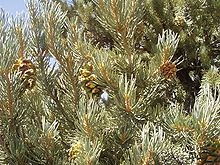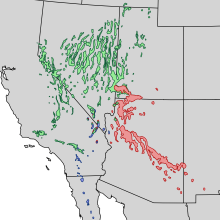Single-leaf pinyon
| Pinus monophylla | |
|---|---|
 |
|
| Single-leaf pinyon (Pinus monophylla subsp. monophylla) leaves and immature cones | |
| Scientific classification | |
| Kingdom: | Plantae |
| Division: | Pinophyta |
| Class: | Pinopsida |
| Order: | Pinales |
| Family: | Pinaceae |
| Genus: | Pinus |
| Subgenus: | Ducampopinus |
| Species: | P. monophylla |
| Binomial name | |
|
Pinus monophylla Torr. & Frém. |
|
 |
|
| Natural range: green - Pinus monophylla subsp. monophylla blue - Pinus monophylla subsp. californiarum red - Pinus monophylla subsp. fallax |
|
Pinus monophylla, the single-leaf pinyon, (alternatively spelled piñon) is a pine in the pinyon pine group, native to the United States and northwest Mexico. The range is in southernmost Idaho, western Utah, Arizona, southwest New Mexico, Nevada, eastern and southern California and northern Baja California.
It occurs at moderate altitudes from 1,200-metre (3,900 ft) - 2,300-metre (7,500 ft), rarely as low as 950-metre (3,120 ft) and as high as 2,900-metre (9,500 ft). It is widespread and often abundant in this region, forming extensive open woodlands, often mixed with junipers in the Pinyon-juniper woodland plant community. Single-leaf Pinyon is the world's only 1-needled pine.
Pinus monophylla is a small to medium size tree, reaching 10-metre (33 ft)-20-metre (66 ft) tall and with a trunk diameter of up to 80-centimetre (31 in) rarely more. The bark is irregularly furrowed and scaly. The leaves ('needles') are, uniquely for a pine, usually single (not two or more in a fascicle, though trees with needles in pairs are found occasionally), stout, 4-centimetre (1.6 in) - 6-centimetre (2.4 in) long, and grey-green to strongly glaucous blue-green, with stomata over the whole needle surface (and on both inner and outer surfaces of paired needles). The cones are acute-globose, the largest of the true pinyons, 4.5-centimetre (1.8 in) - 8-centimetre (3.1 in) long and broad when closed, green at first, ripening yellow-buff when 18–20 months old, with only a small number of very thick scales, typically 8-20 fertile scales. The cones thus grow over a two-year (26-month) cycle, so that newer green and older, seed-bearing or open brown cones are on the tree at the same time (see image at left).
The cones open to 6-centimetre (2.4 in) - 9-centimetre (3.5 in) broad when mature, holding the seeds on the scales after opening. The seeds are 11-millimetre (0.43 in) - 16-millimetre (0.63 in) long, with a thin shell, a white endosperm, and a vestigial 1-millimetre (0.039 in) - 2-millimetre (0.079 in) wing. Empty pine nuts with undeveloped seeds (self-pollinated) are a light tan color, while the "good" ones are dark brown. The pine nuts are dispersed by the pinyon jay, which plucks the seeds out of the open cones, choosing only the dark ones and leaving the light ones (as in image at right). The jay, which uses the seeds as a food resource, stores many of the seeds for later use by burying them. Some of these stored seeds are not used and are able to grow into new trees. Indeed, Pinyon seeds will rarely germinate in the wild unless they are cached by jays or other animals.
...
Wikipedia

